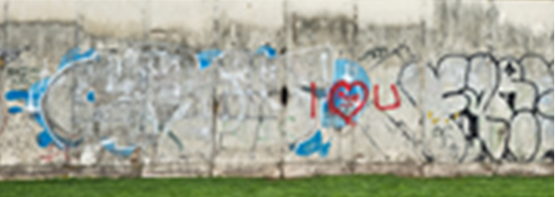Graffiti

Removing graffiti with lasers is an effective and environmentally friendly method, but several considerations must be taken into account to ensure successful results while preserving the
integrity of the underlying surface.
Below are common factors when considering laser cleaning
graffiti
Type of Surface
- Material Composition: Different surfaces (e.g., brick, concrete, metal, wood, glass) respond differently to laser cleaning. Understanding the surface material is crucial for selecting the appropriate laser type and settings.
- Surface Condition: Assess the condition of the substrate. Some surfaces may be more fragile or have previous damage that can be exacerbated by the laser cleaning process.
Graffiti Composition
- Type of Paint: Different types of graffiti paint (aerosol, acrylic, oil-based) can require different laser settings and approaches. Identifying the type of paint can help determine the best laser parameters for effective removal.
- Adhesives and Sealants: If graffiti has been applied over a sealant or adhesive, these materials may need different treatment or additional care to avoid damaging the underlying layer.
Laser Type and Wavelength
- Choosing the Right Laser: Different lasers (e.g., fiber, CO2, or Nd) have unique properties suitable for various materials. The choice of laser should be based on the surface type and the specific requirements of the job.
- Wavelength Considerations: The wavelength affects how the laser interacts with different types of paint and substrates. Understanding the interaction can guide the selection of the most effective laser for the job.
Energy Settings
- Adjusting Power Levels: The energy density and pulse duration must be carefully calibrated to remove graffiti effectively without damaging the surface. Too high energy can lead to surface damage, while too low energy may be ineffective.
- Adjusting Power Levels: The energy density and pulse duration must be carefully calibrated to remove graffiti effectively without damaging the surface. Too high energy can lead to surface damage, while too low energy may be ineffective.
Safety Precautions
- Personal Protective Equipment (PPE): Operators should wear appropriate PPE, including laser safety goggles, gloves, and protective clothing, to mitigate risks associated with laser operation and debris generation.
- Site Safety: Ensure the work area is secured and that bystanders are kept at a safe distance during the cleaning process.
Environmental Considerations
- Minimal Waste: Laser cleaning generates minimal waste compared to traditional chemical methods. However, the process can create fine dust and debris, which should be contained and collected appropriately.
- Chemical-Free Process: The use of lasers eliminates the need for harsh chemicals, making it a safer choice for both the environment and human health.
Testing and Trial Runs
- Conducting Tests: Before full-scale graffiti removal, perform test patches on inconspicuous areas to assess the effectiveness of the laser settings and the surface’s response.
- Monitoring Results: Based on the test results, adjust the approach as needed to optimize the cleaning process.
Post-Removal Treatment
- Surface Restoration: After graffiti removal, assess the surface for any damage or discoloration. Additional treatments, such as surface sealing or repainting, may be necessary to restore the appearance and protect against future vandalism.
- Preventive Measures: Consider applying anti-graffiti coatings or protective films after cleaning to make future graffiti removal easier and to deter new vandalism.
Professional Expertise
- Training and Experience: Proper training in laser operation and surface restoration techniques is essential for achieving optimal results. Professionals should be familiar with the equipment and its application on various substrates.
- Collaboration with Experts: Working alongside conservationists or surface treatment specialists can enhance the effectiveness of the cleaning process and ensure that best practices are followed.
Laser graffiti removal is a highly effective method that requires careful consideration of various factors, including surface type, graffiti composition, safety measures, and post-removal treatment. By addressing these considerations, professionals can successfully remove graffiti while preserving the underlying surfaces and minimizing damage.
